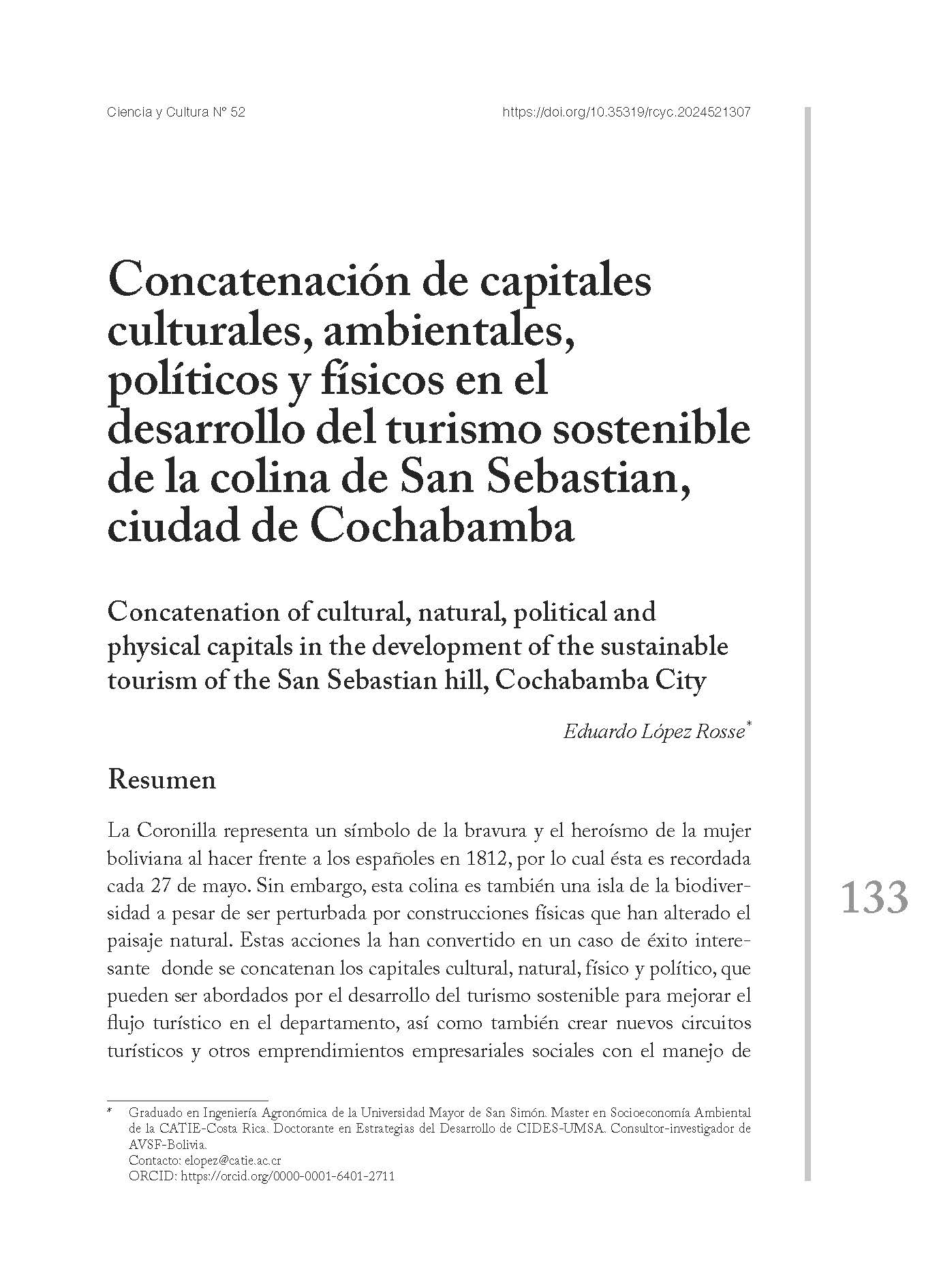Concatenation of cultural, natural, political and physical capitals in the development of the sustainable tourism of the San Sebastian hill, Cochabamba City
DOI:
https://doi.org/10.35319/rcyc.2024521307Keywords:
La Coronilla, Historical patrimony, capitals, biodiversity conservation, islandAbstract
La Coronilla represents bravery and heroines’ symbol of the Bolivian women
to fight Spaniards in 1812; by this act, they are honoured every May 27th.
This hill is also an island for biodiversity and in spite of being disturbed by
construction that affected the natural landscape. These actions had turned La
Coronilla in a successful study case in which four capitals (natural, physical,
political and Cultural) are gathered in order to be employed by the sustainable
tourism development to enhance the international tourism flux and the creation of new tourism circuits and regenerative social endeavours such as the
Non-Wood Forestal Products to finance the maintenance and conservation of
this historical hill located at the centre of the Cochabamba City.
Downloads
References
Aguirre, N. (2005). Juan de la Rosa. Memorias del último soldado de la independencia. Caracas: Biblioteca Ayacucho.
Butler, R.W. (1993) Tourism. An evolutionary perspective. En J.G. Nelson, R.W. Butler y G. Wall (eds.), Tourism and Sustainable Development: Monitoring, Planning, Managing (pp. 27-44), Department of Geography Publication N° 37, Waterloo, Ont.: University of Waterloo.
Bolivia. Gobierno Autónomo Municipal de Cochabamba (2016). Plan territorial de desarrollo integral 2016-2020. Cochabamba, Bolivia.
Bolivia, Estado Plurinacional (2014). Ley N° 530 del patrimonio cultural boliviano. La Paz, Bolivia.
Bolivia. Instituto Nacional de Estadística, INE (2022). Datos estadísticos de turistas extranjeros 2019-2020. La Paz.
Boz, M., S.B. Yurdakul y S. Turdubekova (2017) Yerli Ve Yabancı Turistlerin Sinop’un Kültür Turizmi Çekiciliklerine Ve Altyapısına İlişkin Algıları. Manas, Journal of Social Studies, 6(5), 49-65.
Cronin, L. (1990). A strategy for tourism and sustainable developments. World Leisure and Recreation Journal, 32(3), 12-18. DOI: https://doi.org/10.1080/10261133.1990.10559117
Pearson, R.G. (2016). Reason to conserve nature. Trends in Ecology & Evolution, 31(5),366-371. http://dx.doi.org/10.1016/j.tree.2016.02.005 DOI: https://doi.org/10.1016/j.tree.2016.02.005
Richards, G. (2001). Cultural Attractions and European Tourism. CABI Publishing, New York. DOI: https://doi.org/10.1079/9780851994406.0000
United Nations World Trade Organization, UNWTO (1998). Guide for Local Authorities on Developing Sustainable Tourism. Madrid: UN World Tourism Organization.

Downloads
Published
How to Cite
Issue
Section
License
Copyright (c) 2024 Revista Ciencia y Cultura

This work is licensed under a Creative Commons Attribution-NonCommercial 4.0 International License.








